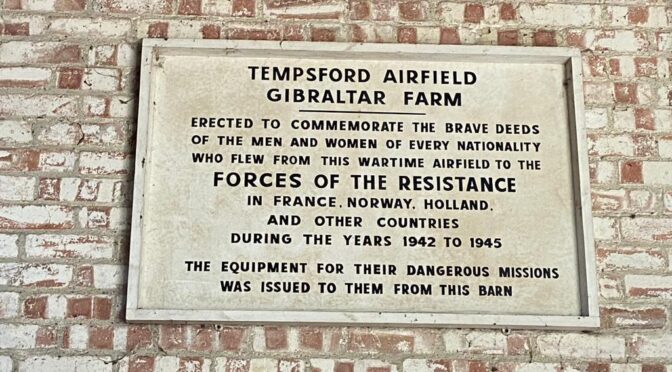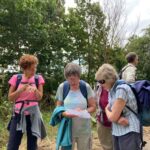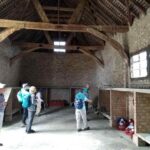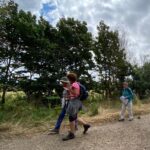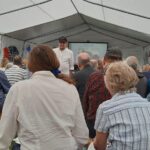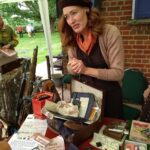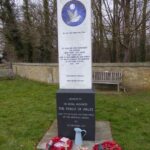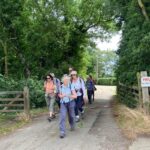Sixteen Polyagents reported for duty at Sandy station. After briefing we set off, up through woods and then along the Greensand Ridge Walk in the valley, northwards on a Roman road with a field of barley waving in the breeze on our left and hawthorn hedge on our right. First stop Gibraltar Barn, formerly part of Gibraltar Farm which was turned into a secret airfield for the RAF during WWII. As we were approaching on a rough but wide farm track, a few cars came towards us and some of the occupants waved at us as they went by. I didn’t inspect them closely which is a shame because the next day, when I returned to the memorial weekend event, I discovered from a French participant that the convoy of cars contained members of the Tempsford Veterans and Relatives Association and colleagues who had been at the Barn holding a memorial service and laying a plaque in French which we observed afterwards without realising how recent it was, honouring the people involved in the Resistance in occupied France. The Barn contains wreaths of poppies, photos and newspaper cuttings, letters and certificates referring to various pilots and Special Operations Executive (SOE) agents who flew from the airfield between 1942 and 1945 to work behind enemy lines. There were plaques in English and Polish (and other languages, including the plaque in French so recently laid there) honouring the men and women involved in the secret operations based at Tempsford and destined not only for France but as far afield as Norway, Denmark, the Netherlands and Poland. Some sources say that the Barn is where the agents were handed their kit before boarding the small planes, Lysanders and Halifaxes, which would take them to their mission on the continent. The historian Mark Seaman giving one of the talks on the Sunday stressed that the people who flew out of Tempsford were agents, whose mission was to send information back to base, liaise with the local resistance, to sabotage and disrupt life for the enemy, not ‘spies’ such as the SIS (Secret Intelligence Service aka MI6) operatives, working out of Godmanchester, who have gained more notoriety and were the object of Roger Leivers’ talk we listened to on the Saturday. As a lot of the relevant information is still classified and evidence needed to be destroyed as soon as possible to minimise the chances of it falling into enemy hands, it is often difficult for historians to research details of the agents’ activities.
We carried on northwards along the wide farm track then westwards, pausing at Knotts Farm shop to buy coffees, eggs, fruit and veg and look at two caged owls and worry about their well-being. As it happened, the farmer was ready to chat about what it was like in the village during the war (as told by parents and neighbours) when the secret airfield was in operation, receiving three visits from the King and Queen but somehow remaining secret, and what it is like now since the A1 slices the hamlet in half and there are no longer any pubs, bakery, post office, butcher or doctor’s cottage, all of which are commemorated by name but not operational, nor any school. There were some very old cottages and also some newer dwellings, possibly for staff at Tempsford Hall which until recently housed offices of part of the Kier construction group (where Mary remembered going for a job interview) and which was where officers were billeted when RAF Tempsford was operational. The farmer said he used to walk to school along the A1 as it was then, not the dual-carriage-cum-motorway which had obstructed our route on the first walkover! On walk day we were able to use an elaborate footbridge to get to our destination and when we were in the countryside on either side of the railway and A1 the noise was barely audible, compared with walks in the vicinity of the M25!
We arrived at Tempsford Museum and Stuart Memorial Hall where proceedings were in full swing, in time for food (tea, cake, fish and chips, sausages etc. and ice cream) to go round the stalls with agents’ equipment, fake documentation, hand grenades, morse code and wireless transmitters, teleprinter etc. plus information about the various agents, pilots and technicians connected with the airfield and the hundreds of WAAFs who worked there, plus the talk about ‘spies’ from Godmanchester using RAF Tempsford. The modern day locals were very friendly and informative as the farmer had been, talking about how everyone realised the planes were flying in and out but how their parents kept it secret.
The Polyramblers were on a different mission and dragged me away at 3pm. Before we left the village, we stopped at the memorial column to female agents on the green, diagonally opposite the church, including amongst others mention of Violette Szabo and Noor Inayat Khan who are also remembered in London along the Embankment by Lambeth Palace and in Gordon Square respectively. There was also a board commemorating young men from the village who died in WWI and a bench in memory of Queen Elizabeth II.
Our route back to Sandy took us along the valley of the River Ivel, across fields and beside the river, pausing at Blunham where there were some empty benches with a view of the church tower, then on between waist-high nettles and brambles (the path having been kept open by a man on a motorised mower which we saw on the other bank) via the Riddy nature reserve, arriving at the station as the London-bound train was just arriving. The next day when I emerged from the station I saw police ribbons across the road outside the Bull pub, which the policeman on guard in his car called a ‘crime scene’! On the way back home, when I casually asked in the pub what had happened I was told there had been ‘an incident’ the evening before (after the Polyramblers had passed by)! Keeping a secret is a tradition in the area!
Thank you to everyone who came on the walk and took an interest in this little known part of our history. Would we be as brave in such circumstances?
Pam
PS On the Sunday, during one of the talks, a member of the audience piped up to let us know that a friend at a show at a nearby airfield had just rung to say that a Lysander would be flying over Tempsford, which we ran out of the marquee to see. It was a very moving sight and a reminder of how small the planes were and the bravery of the people involved.
Photos by Jill and Ida
Further information:
RAF Tempsford Squadrons including a Personnel file of the pilots and details of Remembrance Services and Summer Reunions.

